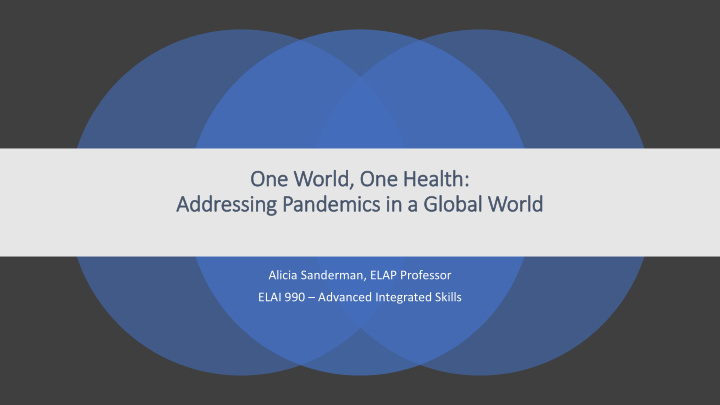



One W e Wor orld, O One H e Heal ealth: Addr ddressing P g Pande ndemics i in n a Globa bal W World Alicia Sanderman, ELAP Professor ELAI 990 – Advanced Integrated Skills
Global Humanities Focus (Spring 2019) • Guiding Principle: expand geographical focus beyond US or any other one country • Currently: • Students’ own knowledge & experiences from their countries • Many readings, TED talks have a US-centric focus • Some materials reference other countries briefly (after- thought) • Analogy: WHO is represented around us? (with positions of power) subconscious effect • Ex: increase in minority representation in entertainment • Asian Americans “Fresh off the Boat” – immigrant stories • African Americans “Black Monday” – shift toward minorities with power and money Sanderman, 2019
Goals for Project Expand Increase Provide Create Facilitate Expand from a single Increase student Provide more Deliberately focus Facilitate immersion country to a global engagement & language on more creative & stage perspective creativity opportunities memorable (“forget” that methods to present How do countries (for all skills) around they’re learning) & receive and cultures the topic information interact? Sanderman, 2019
Big I Idea • There is one global health (affected by animal, human, and environmental factors) that requires us all to cooperate and collaborate to ensure the best outcomes.
1. Read an article about “Outbreak” exhibit in the National History Smithsonian Museum. 2. Visit the “Outbreak” exhibit. 3. Participate in a simulation scenario involving an HIV crisis (State Department). 4. Create a photo essay or create an Adobe Spark digital story about some of the global diseases after additional library research. Integration: Use all four language Project: One Worl rld, One skills to maximize language development. Health Sanderman, 2019
1. Before the Natural History Museum Visit Sanderman, 2019
2. “Outbreak” Exhibit • Content (videos, reading, computer simulation, objects and artifacts) • Take notes, pictures, and video that will enable them to: • track the spread of global diseases & their causes (clarify misconceptions) • re-evaluate the stigma associated with diseased individuals • focus on the importance of global collaboration in order to stop and spread pandemics. …while learning new vocabulary and language structures (rich input) Sanderman, 2019
Global Focus of “Outbreak” • Many countries mentioned (Nigeria, Guinea, Sierra Leone, Liberia, China, Singapore, Vietnam, Canada, South Korea, Malaysia, Bangladesh, US - CO, AZ, NM) • World = interconnected (global travel) Sanderman, 2019
“Outbreak” Exhibit • Focuses on 7 major pandemics: • SARS • MERS • Ebola • HIV/AIDS • Zika • Influenza • Hanta • Scientific explanations about animal and human transmission, urbanization & travel (causes/effects) • Optimistic tone, spirit of collaboration Sanderman, 2019
3. State Department Simulation (HIV Crisis) Sanderman, 2019
Hyp ypotheti tical Si Simulatio ion Sc Scenario io • Increasing HIV/AIDS cases in Daymar. • Officials in Daymar blame the neighboring country of Lateen, which sends migrant workers into Daymar. • Daymar’s government has threatened to close its border with Lateen. • Collaborative meeting of all stakeholder groups to address this issue. Sanderman, 2019
Students as Key Stakeholders • Negotiate a response to the increase in HIV/AIDS and political tensions. • Outcomes: develop skills in critical thinking, collaboration, problem-solving, persuasive communication, and global competence. • https://diplomacy.state.gov/education/about/class -materials/hiv • Fact sheets • Glossary of terms • Tools for Negotiation (supplement with language tips) Sanderman, 2019
4a. Final Project: Photo Essay • Possible research topics: 1. Choose one of the pandemics mentioned in the “Outbreak” exhibit. What are some of the reasons why this disease had a global impact? 2. What are the most effective ways for countries to collaborate in order to slow the spread of global diseases? Use examples from the “Outbreak” exhibit to support your ideas. • Use photos from the exhibit to support your ideas visually within the text. An additional reference from the Library Catalog is required. Sanderman, 2019
• Meet Adobe Spark • Free digital storytelling application • Includes basic templates for inserting photos, videos, voice recording, and text • “Simple” to use • Professional look and multimedia final product • Tutorial by Gloria 4b. Final Project: Barron, ELITE Adobe Spark Video Sanderman, 2019
Global Humanities & Learning Competencies Global Self-Awareness (Milestone 3): Evaluates the global impact of one’s own and others’ specific local actions on the natural and human world. Understanding Global Systems (Milestone 3): Analyzes major elements of global systems, including their historic and contemporary interconnections and the differential effects of human organizations and actions, to pose elementary solutions to complex problems in the human and natural worlds. Personal and Social Responsibility (Milestone 2): Explains the ethical, social, and environmental consequences of local and national decisions on global systems. Implementation: Fall 2019 Sanderman, 2019
Resources • “What Causes Disease Outbreaks and How Can We Stop Them?” https://insider.si.edu/2018/09/what-causes-disease-outbreaks-and-how-can-we- stop-them/ • “How Globalization Changed the Way We Fight Disease” https://www.smithsonianmag.com/smithsonian-institution/how-globalization- changed-way-we-fight-disease-180969222/ • HIV Crisis Simulation https://diplomacy.state.gov/education/about/class- materials/hiv • Library Catalog (for additional research to supplement the information in the exhibit) https://cms.montgomerycollege.edu/libraries/ • Adobe Spark https://spark.adobe.com/ • Tutorial by ELITE Faculty, Gloria Barron
Recommend
More recommend